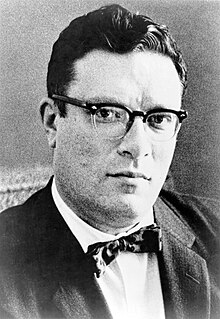When the stars go out
When the stars go out (also The Last Question ; original title: The Last Question ) is a science fiction short story by Isaac Asimov . It was published in November 1956 in Science Fiction Quarterly magazine.
The story tells short episodes from billions of years of human history . A recurring “last question” about the reversibility of entropy forms the leitmotif to which the title refers. On about 14 pages, the story deals with topics such as immortality , transhumanism , artificial intelligence , evolution , cosmology and theology .
content
The humanity serve different story during their computer , which gradually develop artificial intelligence: On Multivac follows Microvac, the Galactic AC, the universal AC, the Cosmic AC and finally AC ( "Automatic Computer").
The “self-correcting and self-regulating” Multivac was originally built in the 21st century to calculate the orbits of distant planets, but on May 21, 2061 a technician asks it the eponymous final question: “Can the entropy ever be reversed?” And Multivac too its further developed forms always give the same answer: "There are insufficient data for a meaningful answer."
The further the time advances, the further the Milky Way and ultimately even thousands of galaxies will be colonized by humans, who develop more and more transhuman to the point of disembodiment. Worried about their own existence and future energy supply - one sun after another burns out and collapses - people keep asking this last, unanswered question.
Finally, in the distant future, one galaxy after the other will be extinguished, the universe will die from heat . Human beings, who have long existed without bodies, merge with the superintelligence AC that exists in hyperspace . Shortly before the very last moment, when all data are recorded and correlated and the universe dies around them, AC can finally answer the last question: "Let there be light!" - and there was light.
reception
Asimov himself considered The Last Question his best short story. He reported that he was repeatedly asked about her by readers who could remember the plot but not the title or author. In The Hitchhiker's Guide to the Galaxy, Douglas Adams made an ironic reference to Asimov's Multivac with the supercomputer Deep Thought : Deep Thought is supposed to answer the question "about life, the universe and all the rest" and after seven million years delivers the answer " 42 " .
Asimov's fictional idea and theological-natural-philosophical speculation about the meaning of life and the "last question" was discussed almost simultaneously by Pierre Teilhard de Chardin (Le Phénomène humain, 1955) in a purely religious context, and later by Frank J. Tipler (The Physics of Immortality, 1994) in a physical context, worked on as omega point theory.
expenditure
- English: The Last Question , in The Best of Isaac Asimov, 1954–1972 , Sphere Science Fiction, London (1977), Ed. Angus Wells
- English: When the stars go out , in Isaac Asimov: When the stars go out (Terra paperback), Pabel (1975)
See also
Web links
proof
- ↑ Isaac Asimov: Best of Asimov . Bastei Lübbe, Bergisch Gladbach 1988, p. 10-11 .
